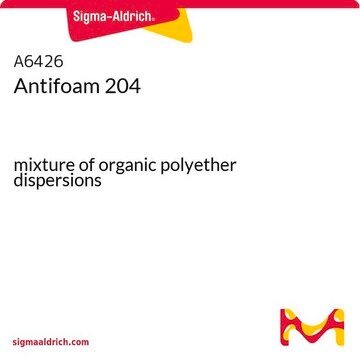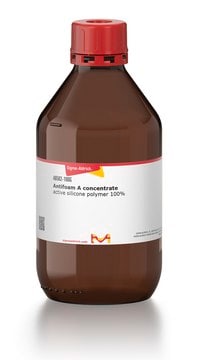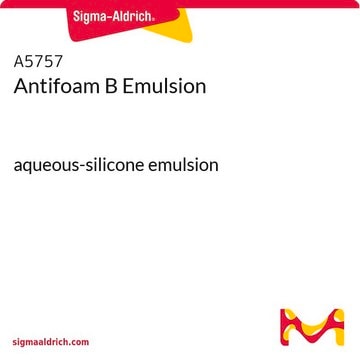A8311
Antimousse 204
aqueous emulsion for bacterial and mammalian systems
Synonyme(s) :
organic antifoam
Sélectionner une taille de conditionnement
Sélectionner une taille de conditionnement
About This Item
Produits recommandés
Niveau de qualité
Forme
emulsion (aqueous)
Concentration
100% (organic)
Densité
1.01 g/mL at 25 °C
Application(s)
microbiology
Température de stockage
room temp
Adéquation
(Mammalian (suspension))
bacteria (fermentation)
Vous recherchez des produits similaires ? Visite Guide de comparaison des produits
Catégories apparentées
Description générale
Application
Antifoam 204 has been used:
- in the expression and purification of PUL (PLAP, Ufd3p, and Lub1p) domain[1]
- in fed-batch fermentation[2]
- to prevent bubble formation due in aeration in Luria Bertani (LB) culture medium for bacterial growth[3]
- in the batch fermentation with mineral medium[4]
Composants
Autres remarques
Notes préparatoires
The optimal amount of antifoam required for various applications will need to be determined. Antifoam 204 is soluble in methanol, ethanol, toluene, xylene, perchloroethylene, and cold water at temperatures below 15 °C. It is insoluble in warm water and ethylene glycol.
Produit(s) apparenté(s)
Code de la classe de stockage
10 - Combustible liquids
Classe de danger pour l'eau (WGK)
WGK 3
Point d'éclair (°F)
Not applicable
Point d'éclair (°C)
Not applicable
Équipement de protection individuelle
Eyeshields, Gloves
Faites votre choix parmi les versions les plus récentes :
Certificats d'analyse (COA)
Vous ne trouvez pas la bonne version ?
Si vous avez besoin d'une version particulière, vous pouvez rechercher un certificat spécifique par le numéro de lot.
Déjà en possession de ce produit ?
Retrouvez la documentation relative aux produits que vous avez récemment achetés dans la Bibliothèque de documents.
Les clients ont également consulté
Filtres actifs
Notre équipe de scientifiques dispose d'une expérience dans tous les secteurs de la recherche, notamment en sciences de la vie, science des matériaux, synthèse chimique, chromatographie, analyse et dans de nombreux autres domaines..
Contacter notre Service technique










